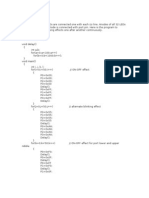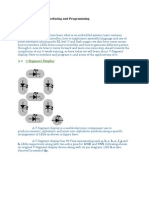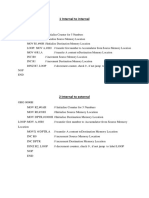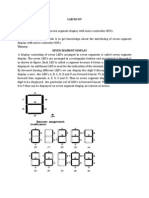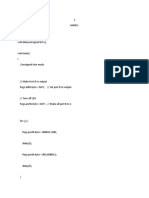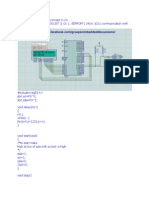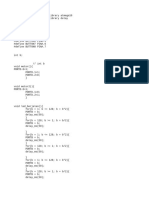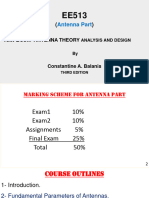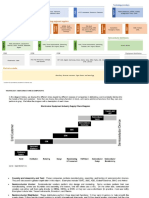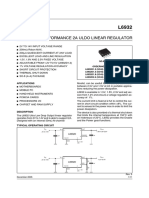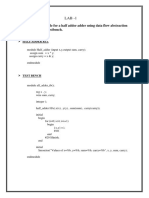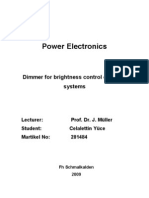+/file Name: DDRT //purpose: Write Programs in C //programmer: Carlos de La Cruz, Terky //date:3/30/2017
Uploaded by
Mil+/file Name: DDRT //purpose: Write Programs in C //programmer: Carlos de La Cruz, Terky //date:3/30/2017
Uploaded by
Mil+/File Name: DDrt
//Purpose: write programs in C
//Programmer: Carlos De La Cruz,Terky
//Date:3/30/2017
Exercise 1
DDRT &= 0x00;
PPST &= 0xF0;
PERT |=0xF0;
DDRH =0x00;
PTT= PTH ;
Lab exercise 1
#include "derivative.h" /* derivative-specific definitions */
// Display PA on 7-seg Display #include "hcs12.h" /* common defines and macros */
void SetClk8(void); /* available from Chapter 06 */
void delayby1ms(int); /* available from Chapter 05 */
void main(void) { /* put your own code here */
SetClk8();
DDRJ |= 0x02;
PTJ |= 0x02; // disable LEDs
DDRP |= 0x0f;
DDRB = 0xff;
while (1) {
PTP = 0xfd;
PORTB = 0x79; // display e
delayby1ms(2);
PTP = 0xfb;
PORTB = 0x38; // display l
delayby1ms(2);
PTP = 0xf7;
PORTB = 0x73;
delayby1ms(2);
PTP = 0xfe;
PORTB = 0x76; // display A
delayby1ms(2);
} /* please make sure that you never leave main */ } ]
\
// Example 1a: Turn on every other segment on 7-seg display
#include <hidef.h> /* common defines and macros */
#include <mc9s12dg256.h> /* derivative information */
#pragma LINK_INFO DERIVATIVE "mc9s12dg256b"
#include "main_asm.h" /* interface to the assembly module */
void main(void) {
/* put your own code here */
PLL_init(); // set system clock frequency to 24 MHz
seg7_enable(); // disable 7-segment displays
led_disable(); // enable LEDs
DDRH = 0x00; // Port H inputs
while(1) {
leds_on(~PTH);
}
Lab exercise 3
// Example 1a: Turn on every other segment on 7-seg display
#include <hidef.h> /* common defines and macros */
#include <mc9s12dg256.h> /* derivative information */
#pragma LINK_INFO DERIVATIVE "mc9s12dg256b"
#include "main_asm.h" /* interface to the assembly module */
void delay(void);
void main(void) {
PLL_init(); // set system clock frequency to 24 MHz
seg7_disable(); // disable 7-segment displays
led_enable(); // enable LEDs
DDRH = 0x00; // Port H inputs
while(1) {
if(PTH!=0xff) { //all dip switches off
leds_on(0x80);//lights up led7
delay();
leds_on(0x20);//lights up led5
delay();
}
else{ //dip switch is down
leds_on(0x01); //lights up led0
delay(); //delay needed in between each led
leds_on(0x04); //lights up led2
delay();
void delay() {
int i,j;
for(i = 0; i < 500; i++) {
for(j = 0; j < 6248; j++) {}
}
}
Lab exercise 4
Step 1
There Are 4 inputs and 4 outputs
Step 2
The 7 segment display can only show four numbers 2 ms for each number that’s 8 ms which generate a
frequency of 125 hz and loop 600/8 =75 which is the number of times you loop the pattern so the delay
can be 600 ms .
Step 3
// Example 1a: Turn on every other segment on 7-seg display
#include <hidef.h> /* common defines and macros */
#include <mc9s12dg256.h> /* derivative information */
#pragma LINK_INFO DERIVATIVE "mc9s12dg256b"
#include "main_asm.h" /* interface to the assembly module */
int i;
void main(void) {
/* put your own code here */
PLL_init(); // set system clock frequency to 24 MHz
DDRB = 0xff; // Port B is output
DDRJ = 0xff; // Port J is output
DDRP = 0xFF; // Port P is output
PTJ = 0x02; // enable LED
PTP = 0x00; // enable all 7-segment displays
// turn on every other led and segment on 7-seg displays
while(1){
for( i=0;i<75;i++){
PTP=0x0E;
PORTB=0x06;
ms_delay(2);
PTP=0x0d;
PORTB=0x5b;
ms_delay(2);
PTP=0x0b;
PORTB=0x4f;
ms_delay(2);
PTP=0x07;
PORTB=0x66;
ms_delay(2);
for( i=0;i<75;i++){
PTP=0x0E;
PORTB=0x5b;
ms_delay(2);
PTP=0x0d;
PORTB=0x4f;
ms_delay(2);
PTP=0x0b;
PORTB=0x66;
ms_delay(2);
PTP=0x07;
PORTB=0x6d;
ms_delay(2);
for( i=0;i<75;i++){
PTP=0x0E;
PORTB=0x4f;
ms_delay(2);
PTP=0x0d;
PORTB=0x66;
ms_delay(2);
PTP=0x0b;
PORTB=0x6d;
ms_delay(2);
PTP=0x07;
PORTB=0x7d;
ms_delay(2);
for( i=0;i<75;i++){
PTP=0x0E;
PORTB=0x66;
ms_delay(2);
PTP=0x0d;
PORTB=0x6d;
ms_delay(2);
PTP=0x0b;
PORTB=0x7d;
ms_delay(2);
PTP=0x07;
PORTB=0x07;
ms_delay(2);
for( i=0;i<75;i++){
PTP=0x0E;
PORTB=0x6d;
ms_delay(2);
PTP=0x0d;
PORTB=0x7d;
ms_delay(2);
PTP=0x0b;
PORTB=0x07;
ms_delay(2);
PTP=0x07;
PORTB=0x7f;
ms_delay(2);
for( i=0;i<75;i++){
PTP=0x0E;
PORTB=0x7d;
ms_delay(2);
PTP=0x0d;
PORTB=0x07;
ms_delay(2);
PTP=0x0b;
PORTB=0x7f;
ms_delay(2);
PTP=0x07;
PORTB=0x6f;
ms_delay(2);
}
for( i=0;i<75;i++){
PTP=0x0E;
PORTB=0x07;
ms_delay(2);
PTP=0x0d;
PORTB=0x7f;
ms_delay(2);
PTP=0x0b;
PORTB=0x6f;
ms_delay(2);
PTP=0x07;
PORTB=0x3f;
ms_delay(2);
for( i=0;i<75;i++){
PTP=0x0E;
PORTB=0x7f;
ms_delay(2);
PTP=0x0d;
PORTB=0x6f;
ms_delay(2);
PTP=0x0b;
PORTB=0x3f;
ms_delay(2);
PTP=0x07;
PORTB=0x06;
ms_delay(2);
for( i=0;i<75;i++){
PTP=0x0E;
PORTB=0x6f;
ms_delay(2);
PTP=0x0d;
PORTB=0x3f;
ms_delay(2);
PTP=0x0b;
PORTB=0x06;
ms_delay(2);
PTP=0x07;
PORTB=0x5b;
ms_delay(2);
for( i=0;i<75;i++){
PTP=0x0E;
PORTB=0x3f;
ms_delay(2);
PTP=0x0d;
PORTB=0x06;
ms_delay(2);
PTP=0x0b;
PORTB=0x5b;
ms_delay(2);
PTP=0x07;
PORTB=0x4f;
ms_delay(2);
}
}
Step 4
You might also like
- Chapter 1 - Electric Circuit Variables: ExercisesNo ratings yetChapter 1 - Electric Circuit Variables: Exercises25 pages
- Lunch Box Switch - Seven Segment Display (CC and CA) : Lab Activity - 7No ratings yetLunch Box Switch - Seven Segment Display (CC and CA) : Lab Activity - 77 pages
- Expt No: 7a Date:19.3.2015 Led Interfacing AimNo ratings yetExpt No: 7a Date:19.3.2015 Led Interfacing Aim36 pages
- MCTE 4105 Mechatronics Lab Iii Sem Ii - Session 19/20 Title: Experiment 5: 7 Segment DisplayNo ratings yetMCTE 4105 Mechatronics Lab Iii Sem Ii - Session 19/20 Title: Experiment 5: 7 Segment Display11 pages
- Workshop 4: Digital Electronics & MicrocontrollerNo ratings yetWorkshop 4: Digital Electronics & Microcontroller2 pages
- Pic 18f452 Implementation of Digital FiltersNo ratings yetPic 18f452 Implementation of Digital Filters5 pages
- Understanding Software Engineering Vol 3: Programming Basic Software Functionalities.From EverandUnderstanding Software Engineering Vol 3: Programming Basic Software Functionalities.No ratings yet
- COILPITTS Ali Hajimiri, Thomas H. Lee - The Design of Low Noise Oscillators (1999, Kluwer Academic Publishers) PDF100% (1)COILPITTS Ali Hajimiri, Thomas H. Lee - The Design of Low Noise Oscillators (1999, Kluwer Academic Publishers) PDF220 pages
- COILPITTS Ali Hajimiri, Thomas H. Lee - The Design of Low Noise Oscillators (1999, Kluwer Academic Publishers)No ratings yetCOILPITTS Ali Hajimiri, Thomas H. Lee - The Design of Low Noise Oscillators (1999, Kluwer Academic Publishers)6 pages
- Directions For Laboratory Exercise 3: L3p2.map L3p2.asm L3p2.exe L3p2.lst L3p2.objNo ratings yetDirections For Laboratory Exercise 3: L3p2.map L3p2.asm L3p2.exe L3p2.lst L3p2.obj8 pages
- Drug Delivery Using Nanotechnology: by Carlos de La Cruz Dr. Oz Global Issues Fairleigh Dickinson UniversityNo ratings yetDrug Delivery Using Nanotechnology: by Carlos de La Cruz Dr. Oz Global Issues Fairleigh Dickinson University11 pages
- Running Head: Work and Leisure in America 0No ratings yetRunning Head: Work and Leisure in America 012 pages
- Peter P. Viez Bicke Yagi Antenna DesignNo ratings yetPeter P. Viez Bicke Yagi Antenna Design44 pages
- (D.E. Stevenson) Programming Language Fundamentals PDFNo ratings yet(D.E. Stevenson) Programming Language Fundamentals PDF218 pages
- F000527 Montarbo EarthPro 115A Datasheet ENG 2019-06-07No ratings yetF000527 Montarbo EarthPro 115A Datasheet ENG 2019-06-072 pages
- EMI-EMC Analysis and Noise Reduction On PCB100% (2)EMI-EMC Analysis and Noise Reduction On PCB47 pages
- Chapter 5 A Closer Look at Instruction Set Architectures: Lecturer: Hao Zheng Comp Sci & Eng, USFNo ratings yetChapter 5 A Closer Look at Instruction Set Architectures: Lecturer: Hao Zheng Comp Sci & Eng, USF50 pages
- Sensor Based Color Identification Robot For Type Casting: Toufeeq AhmadNo ratings yetSensor Based Color Identification Robot For Type Casting: Toufeeq Ahmad6 pages
- UNV MW-A55-B5 LCD Splicing Display Unit V2.0No ratings yetUNV MW-A55-B5 LCD Splicing Display Unit V2.04 pages
- Reliability Analysis Based On Markov Model Economic Feasibility and Efficiency Comparison For A Cascaded H-Bridge Multilevel Inverter Capable of Generating 27 LevelsNo ratings yetReliability Analysis Based On Markov Model Economic Feasibility and Efficiency Comparison For A Cascaded H-Bridge Multilevel Inverter Capable of Generating 27 Levels13 pages
- High Performance 2A Uldo Linear Regulator: ApplicationsNo ratings yetHigh Performance 2A Uldo Linear Regulator: Applications11 pages



